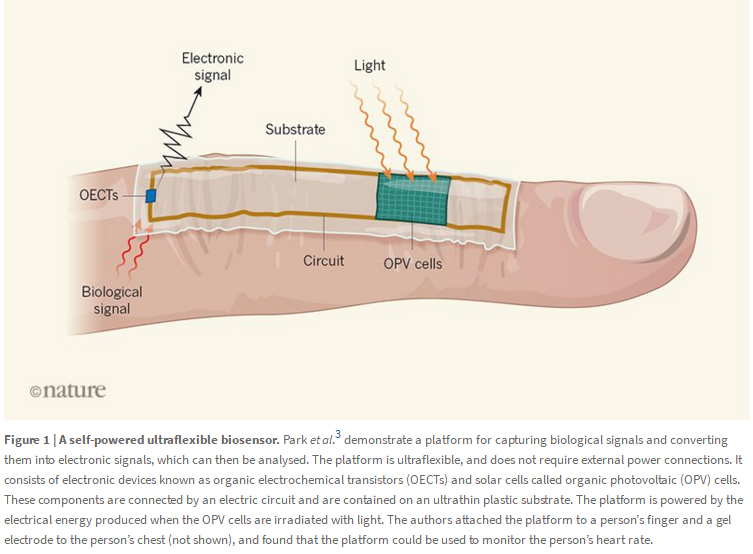Flexible self-powered biosensors
Current biological sensors require bulky external power sources. Ultrathin solar cells have now been fabricated that can power flexible, wearable sensors for the precise and continuous monitoring of biological signals.
Sep.26 2018 byShiming Zhang & Fabio Cicoira from https://www.nature.com/
Flexible electronic devices are emerging as powerful tools for measuring biological signals, such as a person’s heart rate or blood pressure. This is because these devices are lightweight, can bind to human skin and can tolerate mechanical deformation1,2. However, although various flexible biosensors have already been demonstrated, most of them rely on large external power sources to operate. Writing in Nature, Park et al.3 report ultraflexible biosensors, used to monitor heart rate, that are powered by ultrathin solar cells. The integration of ultraflexible power sources and sensors has the potential to revolutionize the technology of self-powered conformable biosensors for applications in wearable electronics and diagnostics.
Park and colleagues achieved this feat by combining solar cells, known as organic photovoltaic (OPV) cells4, with electronic devices called organic electrochemical transistors (OECTs)5,6. The authors fabricated the OPV cells and OECTs on an ultrathin substrate, which was made of a type of plastic known as parylene. The OPV cells could convert up to 10.5% of the energy received from light into electricity — which is among the highest reported values of power-conversion efficiency for ultraflexible devices.
Flexible OPV cells are normally less efficient than their rigid counterparts, which use more-established fabrication processes. Park et al. overcame this limitation by introducing zinc oxide structures into the OPV cells. These structures consisted of nanometre-scale patterns that facilitated electron transport in the OPV cells, maximizing their efficiency.
Park and co-workers produced the nanopatterns using a blank DVD, which has these patterns on its surface to store information. The authors first replicated the DVD’s nanopatterns onto an elastic stamp. They then used this stamp to generate nanopatterns on the OPV cells by a fabrication technique known as soft lithography7.
Another key advantage of Park and colleagues’ OPV cells over rigid solar cells is that the power-conversion efficiency is insensitive to the angle at which the cells are illuminated by light. In conventional solar cells, light that comes in at a greater angle to the surface of the cells undergoes more reflection, leading to a lower efficiency. But in the authors’ devices, the nanopatterns minimize the reflection of incoming light, regardless of the illumination angle. As a result, the efficiency of these devices is unaffected by movement, which is a desirable property for wearable biosensors.
The interest in using flexible OPV cells to power flexible sensors naturally calls for stable electrical performance under mechanical deformation. Conventional flexible OPV cells do not meet this requirement because they are comprised of thick, rigid materials, which make the devices fragile. Park et al. took advantage of the ultrathin nature of their nanopatterned OPV cells and laminated the devices on a pre-stretched elastomer8 (a rubber-like material). They found that the resulting devices could not only be laid on curved surfaces, but could also be stretched to twice their initial length (a mechanical strain of 200%) and still maintain high power-conversion efficiency. Even after 900 cycles of stretching and releasing the devices, the efficiency dropped to only about 75% of its initial value.
Park and colleagues used the nanopatterned OPV cells to drive OECTs, which acted as sensitive and flexible biosensors. Such OECTs are able to work using a low voltage (about 1 volt9), which is well within the powering capacity of the OPV cells. Furthermore, the OECTs can be powered by standard room lighting.
The authors demonstrated that their self-powered OPV–OECT sensing platform can detect biological signals (Fig. 1). They attached the platform to a person’s finger and a gel electrode to the person’s chest. Every heartbeat produced a voltage difference between the electrode and the platform, because of the movement of ions through the person’s body. Such a difference is normally too small to be detected, but was measurable here owing to the high signal amplification achievable with the OECTs.

Park et al. found that, under a constant illumination from light-emitting diodes, the platform recorded clear heart-rate signals. The recording sensitivity was about three times higher than that of OECTs powered by conventional power sources10. This is because the absence of external power connections reduced signal fluctuations.
The authors validated the reliability of their approach in vivo by attaching the sensing platform to the exposed surface of a rat’s heart. They successfully measured the animal’s heart rate, proving the efficacy of the platform for monitoring biological signals.
However, before Park and co-workers’ OPV cells can be fully integrated into wearable devices, several optimizations are needed. The transmission of electronic signals from the platform is still based on conventional rigid silicon-based electronics that are powered by external sources. In addition, the OPV cells produce only low output power, so it will be challenging to drive sensing systems that are complicated or that have high power consumption.
Nevertheless, the OPV cells are a milestone in the production of ultrathin and highly efficient solar cells for self-powering applications. Moreover, the devices pave the way for the development of ultraflexible, stretchable and even healable11,12 self-powered biosensors13 for the precise, sensitive and continuous measurement of biological signals.
Through the efforts of scientists and researchers from companies and research institutions around the world, which also inncluding engineers fromSouthern Sparkle Wearable Technology Co., Ltd, more and more new techologies are merged into clothing, which makes our clothing becomes smarter and smarter, and brings more convenience to people.
If you are ready to upgrade for your clothing brand, welcome to contact us by sending an e-mail tosales@eleheat.com.cn, Eleheat will provide you professional One-Stop Solution for Smart Clothing, Make you Clothing more Functional and Comfortable.
